To clean gutters in Virginia, clear debris, flush using a hose, and check downspouts. Do it yourself is an option, However, hiring professionals can guarantee safety, efficiency, and comprehensive service.
Table of contents
What is a Gutter?
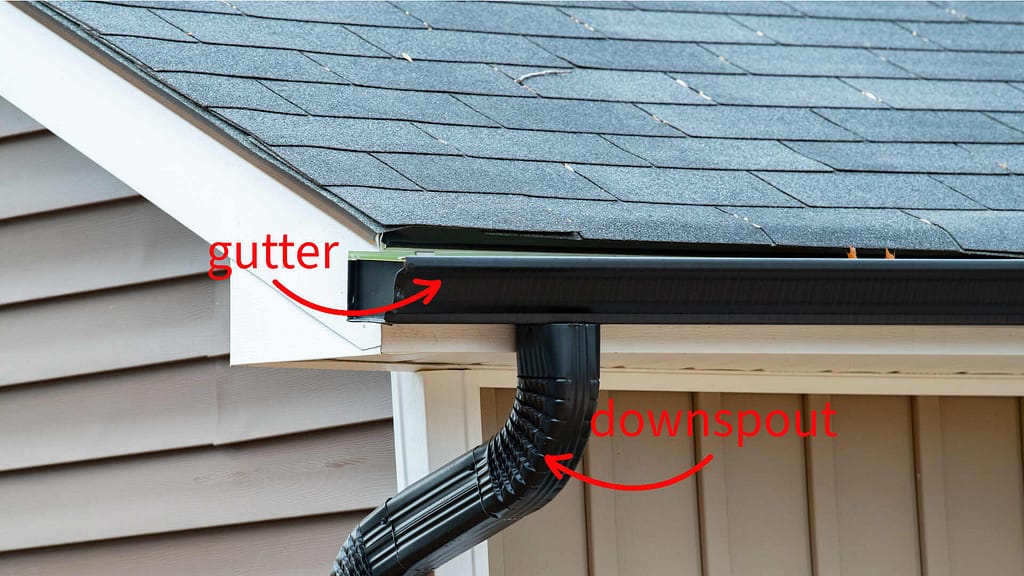
Gutters, in the context of home and building construction, might not be the first thing you notice when admiring a house or structure, but they serve a vital function in preserving its integrity.
A gutter is a narrow channel, or trough, attached to the edge of a roof. Its primary purpose is to collect and divert rainwater shed by the roof away from the foundation of the building. This seemingly simple function is instrumental in preventing many potential problems that can arise from uncontrolled water runoff.
Gutters are part of a system. They work with downspouts, which carry the water collected by gutters to the ground, away from the foundation. This system ensures that rainwater does not pool around the base of your home, preventing potential water damage, soil erosion, and a compromised foundation.
Why Cleaning Gutters is Important?
It’s a task many homeowners overlook or even dread – gutter cleaning. Climbing ladders and getting hands dirty might not sound appealing, but the importance of this task cannot be overstated. Let’s delve into why cleaning your gutters is an essential aspect of home maintenance.
- Preventing Water Damage: This is the primary reason. Clogged gutters can’t efficiently direct water away from your home. When water overflows, it can seep into your roof or walls, causing extensive and costly damage. The foundation, too, can be compromised if water pools around your home’s base.
- Protecting Your Roof: When leaves and other debris pile up, they trap water. This stagnant water can rot the wooden fascia boards your gutters are mounted to. Over time, this can lead to leaks and structural damage to the roof.
- Avoiding Nesting Places for Pests: Clogged gutters can become a breeding ground for mosquitoes, birds, rodents, and other pests. These creatures can carry diseases, and their nesting can lead to further gutter blockages.
- Guarding Against Landscaping Damage: Overflowing gutters can lead to soil erosion, harming your garden beds and any landscaping close to your home’s foundation. The force of water pouring out of clogged gutters can damage plants and shrubs.
- Maintaining Home Value: Beyond the structural implications, well-maintained gutters enhance your home’s curb appeal. They prevent unsightly stains on the exterior and contribute to the overall aesthetics of your residence.
- Avoiding Basement Flooding: A clogged gutter system can result in water pouring next to the foundation of your home, increasing the chances of basement flooding. Keeping your gutters clean can be a preventive measure against this costly issue.
Maintenance
Regular checkups on your gutters can extend their life and reduce potential added costs in the future. Not only is it affordable but quick and easy. Next time you see a gutter overflowing or hanging abnormally consider getting a gutter tune-up. Gutter tune-ups cover the basics including:
- Cleaning of up to 100 Linear Feet of Gutters
- Sealing and Caulking of Gutters (Miter Joints, Outlets, and End Caps)
- Tightening of Gutters and Downspouts – Using Existing Fasteners and Brackets
- Testing of Gutter Slope for Proper Water Flow
- Visual Inspection of Run-Off and Ground Drainage
- A Full Attic, Roof, Gutter & Exterior Inspection – with Photos
Best part is they’re only $149!
Guide to Cleaning Gutters
Maintaining clean gutters is a fundamental aspect of home upkeep, ensuring effective water drainage and protection against potential structural issues. While the task might seem daunting, breaking it down into manageable steps can make the process straightforward and efficient.
Safety First: Understanding the Risks of DIY Gutter Cleaning
Cleaning gutters might seem like a simple chore on the surface, but diving deeper reveals an array of dangers that every DIY enthusiast should be aware of. Before embarking on this task, it’s imperative to arm yourself with knowledge about the potential hazards and ways to mitigate them. Here’s a comprehensive look at the risks associated with DIY gutter cleaning:
Falling from Heights

Arguably the most significant risk associated with gutter cleaning is the possibility of falling. Climbing ladders or navigating rooftops presents inherent dangers, and even a momentary lapse in concentration can lead to a fall. According to a report by the Consumer Product Safety Commission, over 164,000 emergency room visits and approximately 300 fatalities in the U.S. in a single year were related to ladder mishaps (Source). A considerable number of these incidents occurred during activities similar to gutter cleaning. It’s essential to use a sturdy ladder, preferably with stabilizers, and to always maintain three points of contact (two feet and one hand or two hands and one foot) while climbing.
The inherent risks of climbing ladders and working at heights can’t be overstated. Given the alarming statistics related to ladder accidents, we strongly advise against tackling gutter cleaning on your own. It’s wiser and safer to entrust this task to trained gutter maintenance professionals.
Electrocution
Many residences have electrical lines running adjacent to or above their rooftops. During the cleaning process, there’s always a lurking danger of inadvertently touching or getting too close to these power lines. Electrocution can cause severe burns, cardiac arrest, and even death. Always be aware of your surroundings, and if your house is close to power lines, consider using a wooden or fiberglass ladder since they don’t conduct electricity.
Insect Bites and Allergens
Gutters can often become a haven for various pests. Wasps, bees, and hornets might build their nests in these secluded spaces. Accidentally disturbing their habitat during cleaning can result in painful stings. Moreover, the debris that accumulates over time can house allergens like mold spores and pollen. Inhaling or coming into contact with these can lead to allergic reactions, including skin rashes, respiratory issues, or eye irritations. Wearing gloves, safety goggles, and a mask can offer some protection.
Gutter Damage
While the primary intent is to clean and maintain, without the right approach or tools, there’s the potential to damage the gutters themselves. Exerting excessive force, scraping too hard, or using ill-suited equipment can lead to issues like dents, cracks, or even causing parts of the gutter system to come loose. This not only defeats the purpose of cleaning but also adds an unexpected expense for repairs.
Gutter cleaning, while essential, is riddled with potential hazards. Equip yourself with the right knowledge, tools, and safety measures. If you’re ever in doubt about your capability or the risks involved, it’s wiser to hire professionals who are trained and equipped to handle the job safely. The peace of mind and assurance of safety are well worth the investment.
Removing Large Debris
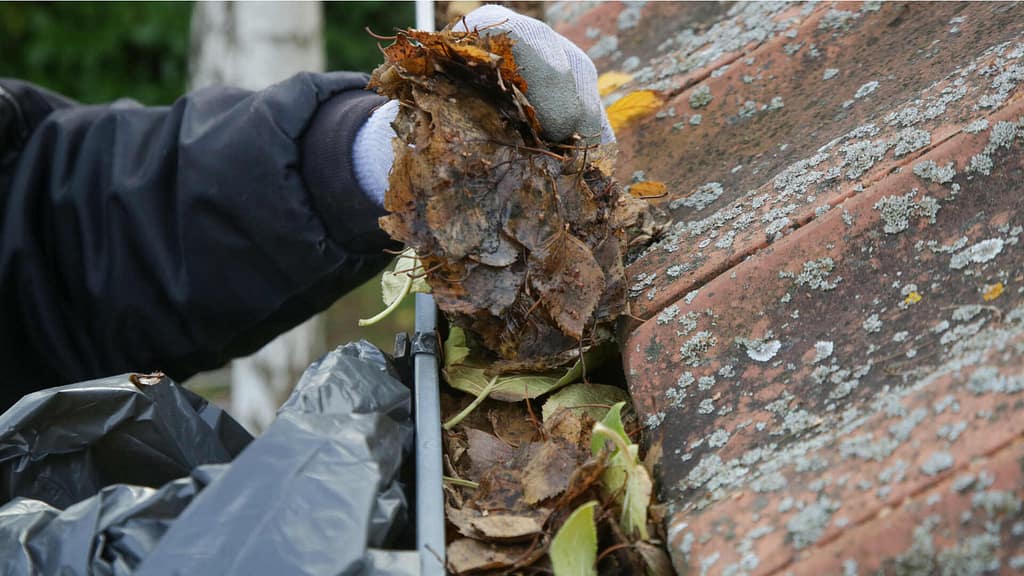
Cleaning your gutters begins with the removal of large obstructions like leaves, twigs, and sometimes unexpected items like toys. For safety, always ensure your ladder is firmly positioned. When you start, approach the downspout first and progress outwards, ensuring debris has a clear exit point.
With sturdy work gloves on, use your hands to gently pull out the debris, depositing it in a bucket or trash bag. Always be cautious of any nests or critters that might have made a home in the gutters. Instead of pushing and compacting the debris, it’s best to pull it towards you for efficient removal.
As you proceed, be wary of gutter hangers and brackets to prevent any damage. To maintain safety, reposition your ladder as needed rather than overreaching. Always prioritize safety, and if ever in doubt, consider hiring a professional.
Scooping Out Smaller Debris

Once the larger obstacles are out of the way, it’s time to focus on the finer particles that tend to accumulate at the bottom of your gutters. Over time, these smaller bits, consisting of pine needles, granules from shingles, seed pods, and the like, create a sludgy layer that can obstruct water flow.
For this task, a gutter scoop proves invaluable. These are specially designed tools that fit the contour of most gutters, making the removal of this muck easier. Starting near the downspout, slide the scoop along the gutter’s length, collecting the finer debris. Using a plastic scoop is recommended, as metal tools could potentially damage the gutter or speed up its wear.
Ensure you have a bucket or a sturdy trash bag by your side to dump the debris. If you’re environmentally conscious, consider composting the organic material you’ve collected. It’s a natural mulch that gardens love!
While scooping, also be aware of the consistency of the material. If it’s been a while since the last clean, you might encounter wet, compacted layers. Break them up gently and ensure you’ve cleared as much as possible. An efficiently flowing gutter system starts with ensuring the tiniest obstructions are removed.
Flushing the Gutters
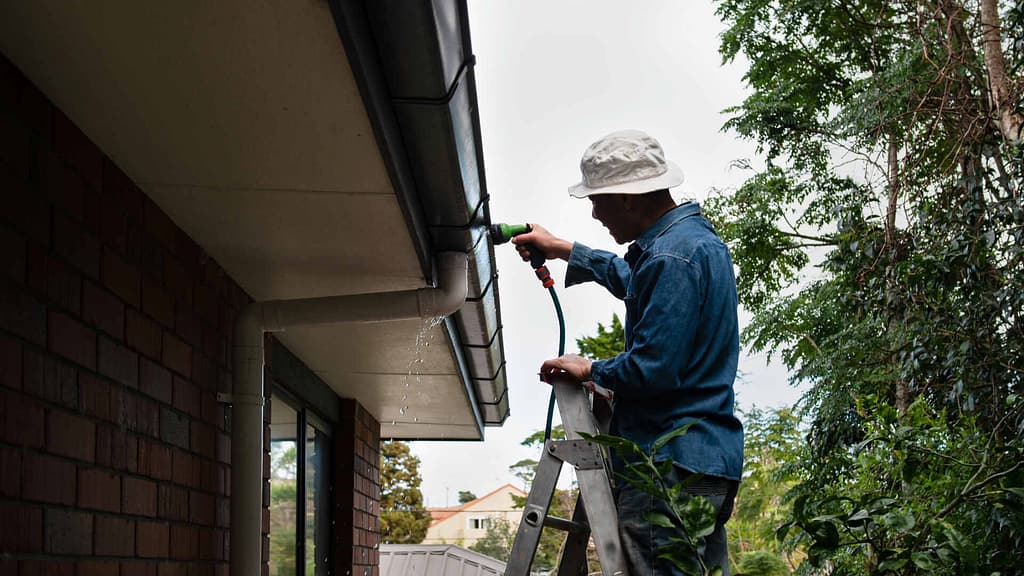
Flushing your gutters is like giving them a refreshing rinse after a thorough scrub. It ensures that any remaining minute particles or loose debris is washed away, restoring the smooth flow of water through the system.
To begin, you’ll need a garden hose with a high-pressure nozzle. Starting from the end opposite the downspout, open the hose to its maximum pressure and let the water rush through. This action will not only help clear out any leftover debris but will also give you a clear picture of any potential leaks or weak points in your gutter system.
Watch the water’s flow carefully. It should move steadily toward the downspout. If you notice any stagnant pools of water or areas where the water isn’t draining effectively, you may have a sagging gutter or another structural issue to address.
When flushing near the downspout, pay particular attention. This is a common spot for clogs to form. If water seems to be backing up or not flowing freely out the downspout, there might be a blockage that needs attention.
It’s also a great idea to let the water flow through for a few minutes and then check the ground below the downspouts. This will show you if the water is being effectively channeled away from your home’s foundation, which is one of the primary functions of a good gutter system.
Concluding your flushing session, turn off the hose and let the gutters drain completely. Take this moment to admire the free-flowing water and take pride in restoring your gutter system to its optimal functioning state.
Checking Downspouts
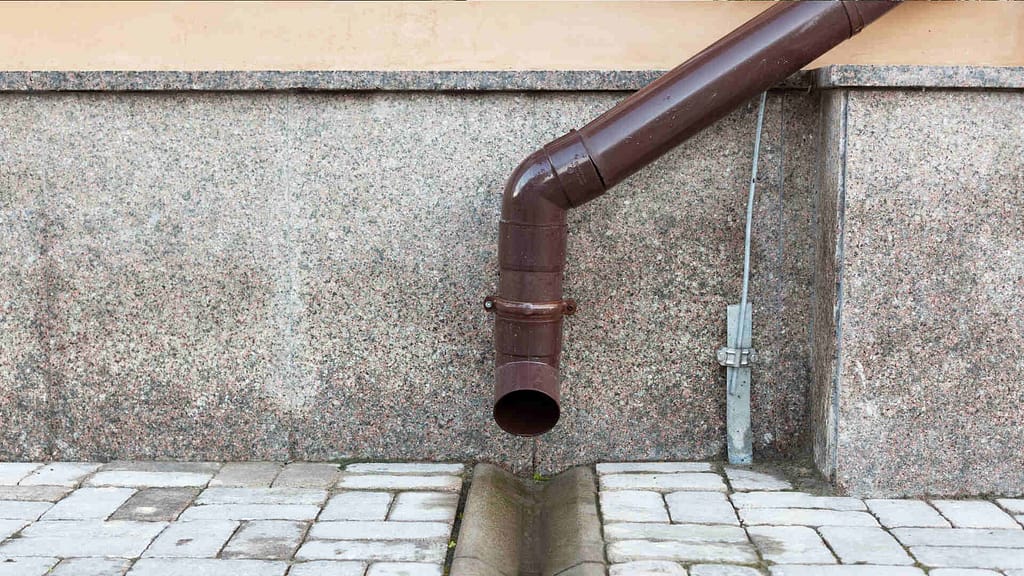
Downspouts are vital conduits that channel rainwater from gutters to the ground. Their health is essential to prevent water damage to your home. To ensure they’re working efficiently, observe the water flow while flushing the gutters. A steady outflow indicates a clear path, while a trickle suggests a blockage.
If there’s a suspected clog, inspect the top of the downspout. Many blockages can be dislodged with a simple tool like a plumber’s snake. If you’re still facing issues, some parts of the downspout may need to be temporarily disassembled for a thorough cleaning. At the ground level, confirm that water is directed away from your home’s foundation.
Installing a strainer at the downspout’s entrance can preemptively stop debris, making future cleanings easier. Regular checks and maintenance of these channels are essential for the long-term well-being of your property.
Installing Gutter Guards (Optional)
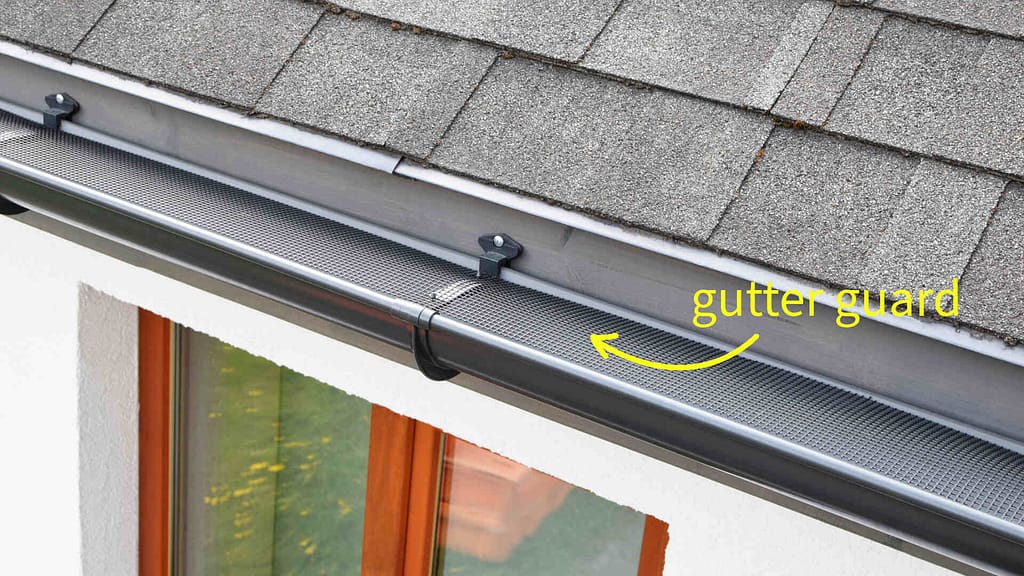
Gutter guards, though optional, offer homeowners an effective way to reduce the hassle of frequent gutter cleanings. These protective layers come in various types, from mesh and bottle brush guards to reverse curve and foam versions. Each design aims to prevent debris accumulation while ensuring water flows freely.
The primary advantages of gutter guards include lessened maintenance, prevention of clogs, and potentially extending the lifespan of your gutters. If considering this addition, it’s crucial to choose a snug-fitting guard and adhere to the manufacturer’s installation guidelines.
While they can be cost-effective in the long run, remember that even with guards in place, occasional gutter inspections are still necessary. For those uncertain about the installation process, seeking professional help can be beneficial.
Alternative Cleaning Methods
Beyond the traditional methods of manually scooping out debris, several alternative approaches can effectively clean gutters. For homeowners looking to switch things up or tackle specific challenges, these methods might prove useful:
- Leaf Blowers: Many modern leaf blowers come with nozzle attachments that allow you to access and blow out the debris from your gutters. While standing on a ladder, you can use the blower to push leaves, twigs, and other debris out of the gutter. This method is particularly effective for dry debris, though it can get messy, so it’s recommended to wear safety glasses and a dust mask.
- Power Washing: For those stubborn areas laden with stuck-on dirt and grime, a power washer can provide the necessary force to clean your gutters thoroughly. However, use this method with caution. Ensure that the force isn’t so strong that it damages the gutters. Also, proper safety gear, like goggles, should be worn to prevent debris from splashing into your eyes.
- Wet/Dry Shop Vacuum: Some homeowners use a wet/dry shop vacuum with an extended hose to suck up debris from the gutters. This method can be efficient, but it requires careful handling to ensure you don’t damage the gutters or pull them away from the house due to the vacuum’s force.
- Robotic Gutter Cleaners: As technology advances, there are robotic devices specifically designed to traverse your gutters and brush away the debris. They operate similarly to robotic vacuum cleaners but are designed for gutter terrain.
Tips for Virginia and Maryland Homeowners
Virginia’s unique climate and seasonal changes can present specific challenges for homeowners. Here are some tailored tips for those residing in the Old Dominion to ensure their gutters remain in top-notch condition:
Seasonal Maintenance
Virginia and Maryland’s ever-changing seasons bring about distinct challenges for homeowners, particularly when it comes to gutter maintenance. As the leaves change and the temperatures dip, it becomes crucial to ensure your gutters are prepared for what’s ahead. As a result, twice-yearly gutter checks are advisable. In late fall, after most of the leaves have fallen, clear out the accumulated debris. A second check in early spring can help remove any winter debris and check for any ice damage.
Fall is a picturesque season in Maryland & Virginia, with trees shedding leaves in a vibrant display of reds, yellows, and oranges. But those beautiful leaves can quickly become a nuisance when they end up in your gutters. Over time, these leaves, combined with twigs and other debris, can create blockages. If left unattended, these blockages can lead to stagnant water, which can be a breeding ground for pests and mold.
Furthermore, the importance of cleaning out your gutters before the freezing temperatures set in cannot be emphasized enough. When blocked gutters are filled with water, the arrival of colder temperatures can cause that water to freeze. This not only adds unnecessary weight to the gutters, potentially causing them to sag or break, but the expanding ice can also create cracks in the gutter system. As the ice melts during the daytime and refreezes at night, these cracks can widen, leading to leaks and further damage to the home’s exterior.
By ensuring your gutters are cleaned out in the fall, you prevent these issues from arising. It’s not just about keeping the gutters clean; it’s about protecting the structural integrity of your home and avoiding costly repairs down the line.
Local Virginia Regulations

Virginia, with its diverse climate, sees a mix of weather events throughout the year, from snow in the winter to heavy rain in the warmer months. As a result, the state has regulations in place to ensure homeowners manage stormwater appropriately, safeguarding both their properties and the broader community.
- Storm Water and Sewage Separation: As per the Virginia Plumbing Code, homeowners must be cautious about where they direct their stormwater. Specifically, stormwater cannot be drained into sewers that are exclusively intended for sewage. This distinction is essential to prevent overburdening the sewage system and potential contamination.
- Direction of Drainage: The code mandates that water from roofs and other paved areas must be channeled to a designated place of disposal. For most residential properties, stormwater can be directed onto broad, flat surfaces such as streets or lawns. However, the stipulation is that the water must flow away from the residence, ensuring no pooling or potential damage to the building’s foundation.
- Conformity to Standards: Any roof drains installed should align with either the ASME A112.6.4 or ASME A112.3.1 standards. Adherence to these norms guarantees that the drains are effective and up to par with safety requirements.
- Gutter Dimensions: The size of the gutters plays a pivotal role in effective drainage. Semicircular gutters, in particular, should be sized based on the roof’s maximum projected area, as detailed in Table 1106.6 of the plumbing code.
For Virginia residents, staying informed about these regulations is paramount. Beyond the legal aspect, these standards protect homeowners from potential water damage, structural issues, and associated costs. Always consult local experts or contact professionals to ensure compliance, safety, and effective water management.
Hiring Professionals
Opting to hire professionals for gutter cleaning and maintenance can be a wise choice for many homeowners. One of the foremost reasons homeowners choose professionals is to avoid the risks associated with climbing ladders and working on roofs. Professionals have the necessary equipment and training to work at heights safely, reducing the risk of accidents or injuries.
With experience comes speed and efficiency. Professionals can often complete the job in a fraction of the time it might take an average homeowner, all while ensuring thorough cleaning and maintenance. They also come equipped with specialized tools that can make the cleaning process more effective. Experts use high-powered vacuums, cameras to inspect downspouts, and tools designed for specific types of debris to cover all needs.
Reputable gutter cleaning companies will have insurance, protecting homeowners in the rare event of damage or accidents. Moreover, many offer guarantees on their work, giving you peace of mind. While hiring professionals might seem like an added expense, in the long run, it can be cost-effective. Ensure you maintain your gutters well and spot potential issues early to avoid significant, costlier repairs down the line.
When considering hiring a professional gutter cleaning service, it’s essential to do your research. Look for companies with excellent reviews, ask for references, and get multiple quotes to ensure you’re getting the best service for your money. Remember, the health of your home’s gutter system is crucial, and sometimes, entrusting it to the experts is the best route to take.
Conclusion
Maintaining gutters is essential for every Virginia & Maryland homeowner. While the blog offers insight into the various steps and methods of gutter upkeep, it’s clear that the task can be intricate and potentially risky. While DIY methods might seem appealing, the expertise and efficiency professionals bring are unmatched. By hiring experts, you not only ensure the longevity of your gutter system but also prioritize your safety and peace of mind. It’s a worthwhile investment in the bigger picture of home maintenance.
Fact checked by Jacob Petrosky – 10/23/23